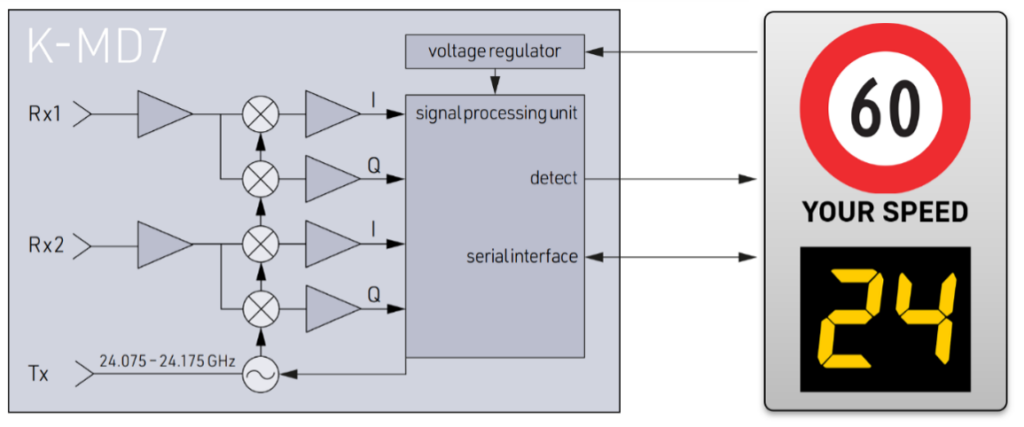

Radar speed signs have become indispensable tools in promoting road safety by alerting drivers to their speed and encouraging compliance with speed limits. Leveraging advanced radar technology, the K-MD7 radar sensor offers a comprehensive solution for radar speed sign applications, providing accurate speed measurement, multi-target tracking, and a customizable detection zone. In this technical guide, we explore the advantages of integrating the K-MD7 sensor into radar speed signs and provide insights into configuring the system for optimal performance.
Sensor features
- Small and low cost digital 24 GHz traffic radar sensor
- Low power consumption of app. 250 mW
- Measures speed, direction, distance and angle of moving objects (2D)
- Perfect for speed signs or simple traffic counting applications
- Maximum speed range of 200 km/h and distance range of 300m
- Typical detection distance of 50m for persons and 150m for cars
- Multi-target tracking for up to 8 moving objects
- Target list output over serial UART interface
- 34 x 30 degree antenna beam pattern
Low Power Consumption
The K-MD7 radar sensor boasts remarkably low power consumption, requiring only 250 mW for speed measurements up to 100 km/h. This feature makes it an ideal choice for energy-efficient applications, particularly for solar-powered speed sign installations.
Advantages of Distance and Angle Measurement
One of the key advantages of the K-MD7 sensor lies in its ability to accurately measure both the distance to moving objects and their angle relative to the sensor’s position. This feature is particularly valuable in radar speed sign applications, as it allows for precise determination of a vehicle’s approach towards the sign and its orientation on the road. By knowing the distance and angle to the vehicle, the speed sign can adjust its display and activation parameters accordingly, ensuring timely and relevant speed feedback to drivers.
Customizable Detection Zone
The K-MD7 sensor offers the flexibility to define a single customizable detection zone based on user-defined parameters. This feature enables the speed sign to trigger its activation only when a vehicle enters the specified zone, optimizing power consumption and minimizing false alarms. By configuring the detection zone according to road conditions and speed limit enforcement requirements, users can tailor the radar speed sign for maximum effectiveness and efficiency.
Speed Sign Application
The K-MD7 sensor is ideally tailored for standalone speed sign applications, requiring minimal external components for seamless integration. With a streamlined design, the digital detection output directly triggers the speed sign, while the serial interface facilitates configuration of detection settings and transmission of speed information to the speed sign controller.

Configuring the K-MD7 radar sensor for speed sign applications is crucial for optimizing its performance. The sensor includes various filters in its signal processing, which can be configured by the speed sign controller. These filters allow for precise customization of detection parameters to suit specific road conditions and enforcement requirements.
Speed Filter
The K-MD7 sensor offers the capability to define upper and lower speed limits. This feature is particularly useful for filtering out slow-moving objects such as pedestrians, leaves in the wind, or rain, ensuring that the speed sign only triggers for vehicles within the desired speed range.
Direction Filter
Users can utilize the direction filter to focus exclusively on approaching traffic while filtering out receding traffic. This functionality is ideal for speed sign applications where only approaching vehicles are of interest, enhancing the efficiency and accuracy of speed detection.
Sensitivity Adjustment
The K-MD7 sensor features an adjustable sensitivity or threshold parameter, allowing users to fine-tune the detection algorithm’s sensitivity. By optimizing sensitivity levels, users can ensure that the sensor accurately detects objects of interest within the specified distance range, enhancing the reliability of speed measurement.
Detection Zone Trigger
Users can define a detection zone by distance and angle, enabling the sensor to trigger detection when an object is detected within the specified area. This feature facilitates efficient power management by activating the speed sign only when a valid detection occurs, conserving energy and extending battery life.
By leveraging these filtering options, users can tailor the K-MD7 radar sensor to their specific speed sign applications, ensuring optimal performance and reliable speed enforcement on the roads.
Easy Evaluation with the K-MD7 Evaluation Kit

To facilitate the development process and enable customers to evaluate the performance of the K-MD7 radar sensor, an evaluation kit is available. This kit provides a simple and efficient way to test all the described features of the sensor in combination with a user-friendly graphical user interface (GUI).
Powerful Control Panel GUI
The kit includes a powerful control panel GUI, enabling users to easily configure sensor settings and parameters by simply connecting the evaluation kit over USB to a host PC.
Real-time Streaming and Visualization
Users can stream and visualize all sensor data in real-time, allowing for immediate observation and analysis.
Data Recording and Playback
The kit supports data recording and playback, including video, using a webcam. This feature enables users to capture and review sensor data for comprehensive evaluation.
Advantages of using the K-MD7
Compared to traditional designs with standard components, integrating the K-MD7 radar sensor into radar speed sign applications offers several distinct advantages:
- Fast time to market, because no signal processing has to be developed
- FFT doppler and range processing results in superior detection range
- Range processing allows to alert a driver at always the same distance, no matter if car or truck
- Ranging and angle processing can solve most problems of doppler only speed sign installations
- High immunity against interference sources like raining and moving plants
In summary, the K-MD7 radar sensor presents a more advanced and cost-effective solution for radar speed sign applications. Its integrated features, superior performance, and immunity against interference make it a reliable choice for enhancing road safety and promoting compliance with speed limits.
Product Links
K-MD7 Sensor
K-MD7 Evaluation Kit
